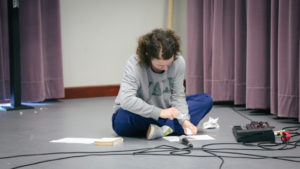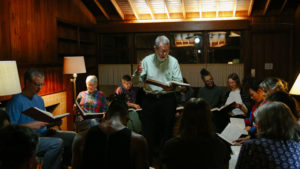Creative Process Taken Beyond the Studio with MANCC’s Entrypoints Program
As the one of the only choreographic centers in the United States that is located within a research university, MANCC supports the needs of dance makers working professionally in the field. Beyond providing time and space in Montgomery Hall’s dance studios along with financial support, MANCC offers a unique research development program called ‘Entrypoints’, which enables artists to deepen their creative inquiries around the work that they are developing, often for national stages. These research opportunities can range from one-on-one conversations with scholars, engagements with FSU students and faculty as well as local community groups, symposium-style forums, site visits to historic landmarks, workshops, open rehearsals and public work-in-progress showings.
MANCC’s 2018-19 season artists utilized the full range of Entrypoint possibilities. The following include selected examples of such research activities. Artist Alice Sheppard (NYC) developed her work DESCENT in August/September 2017 prior to the work’s premiere at the Britt Festival in Oregon. While at MANCC, she worked with Digital Scholarship Technologist Matthew Hunter to create a 3D printed model of the work’s architectural set design. Sheppard’s residency, like many at MANCC, culminated in a public work-in-progress showing for students and faculty; the audience also included members of the local disabled community, disability rights advocates and the Tallahassee Rollergirls team.
Jeanine Durning (NYC) further developed her solo work, dark matter, selfish portrait, in two successive residencies in January and June 2018. During this time, she connected with Dr. Stanley Gontarski, Robert O. Lawton Distinguished Professor of English, on Samuel Beckett’s oeuvre, and with astrophysicist Dr. Jeremiah Murphy on the theory of dark matter; both opportunities more deeply informed her creative thinking on the work. Rosie Herrera (Miami), who trained as a classical opera singer before becoming a choreographer, is deeply interested in the physical and emotional healing potential of sound, particularly the voice. While in residence to develop Make Believe based on ideas of religion, romance and magic, she and her cast attended two singing groups; the Sacred Harp Singers and the local chapter of the Threshold Choir, which gathers to sing songs of comfort and joy to those “at the thresholds of life.”
One of MANCC’s Mellon-funded artists, Ann Carlson (Santa Monica) continued to develop Dumbo Redacted in February 2018. While in residence, she met with FSU Flying High Circus Director Chad Mathews to discuss the history and structures of traditional circus performance in the U.S. and the politics of animals as entertainers and laborers. Jumatatu Poe (Philadelphia) first came to MANCC during a site visit in October 2017 to begin his research, which included connecting with FAMU’s Diamond Dance Team. With his ten collaborators, his residency in March supported the development of his Let ‘Im Move You series, which utilizes the J-sette movement vocabulary found in majorette teams, like the Diamonds. In the second week of the residency, Poe and his collaborators held two informal work-in-progress showings.
Rosy Simas (Seneca, Heron) (Minneapolis) came to MANCC in February and March 2018 to develop Weave, which crafts stories through the artist’s embodied lens as a Native feminist movement and image-maker. While on campus, Simas connected with Dr. John Lowe and Dr. Melesa Kelley (both Cherokee), who lead FSU’s Center for Indigenous Nursing Research for Health Equity. She also conversed with Susan Anderson and Roy Stanley (Creek/Cherokee), local native rights activists. Then in March 2018, Rashaun Mitchell and Silas Riener (NYC) with writer Claudia La Rocco (CA) took their improvisational score for Desire Lines: translation all over campus in pop-up performances in outdoor locations, testing the bounds of where performance ends and life begins.
The Entrypoints Program, unique among residency centers around the country, is facilitated in close collaboration with resident artists by MANCC’s Research Associate, a Mellon-funded position that both cultivates new audiences for dance as well as supports the creative process by making connections with and for artists.
For more information on these residencies, click here.
 The Maggie Allesee National Center for Choreography (MANCC), at the FSU School of Dance, is a choreographic research and development center whose mission is to raise the value of the creative process in dance.
The Maggie Allesee National Center for Choreography (MANCC), at the FSU School of Dance, is a choreographic research and development center whose mission is to raise the value of the creative process in dance.


